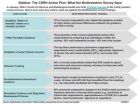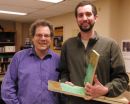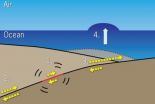(Press-News.org) A Monash student has made a breakthrough in the field of astrophysics, discovering what has until now been described as the Universe's 'missing mass'. Amelia Fraser-McKelvie, working within a team at the Monash School of Physics, conducted a targeted X-ray search for the matter and within just three months found it – or at least some of it.
What makes the discovery all the more noteworthy is the fact that Ms Fraser-McKelvie is not a career researcher, or even studying at a postgraduate level. She is a 22-year-old undergraduate Aerospace Engineering/Science student who pinpointed the missing mass during a summer scholarship, working with two astrophysicists at the School of Physics, Dr Kevin Pimbblet and Dr Jasmina Lazendic-Galloway.
The School of Physics put out a call for students interested in a six-week paid astrophysics research internship during a recent vacation period, and chose Ms Fraser-McKelvie from a large number of applicants. Dr Pimbblet, lecturer in the School of Physics put the magnitude of the discovery in context by explaining that scientists had been hunting for the Universe's missing mass for decades.
"It was thought from a theoretical viewpoint that there should be about double the amount of matter in the local Universe compared to what was observed. It was predicted that the majority of this missing mass should be located in large-scale cosmic structures called filaments - a bit like thick shoelaces," said Dr Pimbblet.
Astrophysicists also predicted that the mass would be low in density, but high in temperature - approximately one million degrees Celsius. This meant that, in theory, the matter should have been observable at X-ray wavelengths. Amelia Fraser-McKelvie's discovery has proved that prediction correct.
Ms Fraser-McKelvie said the 'Eureka moment' came when Dr Lazendic-Galloway closely examined the data they had collected."Using her expert knowledge in the X-ray astronomy field, Jasmina reanalysed our results to find that we had in fact detected the filaments in our data, where previously we believed we had not."
X-ray observations provide important information about physical properties of large-scale structures, which can help astrophysicists better understand their true nature. Until now, they had been making deductions based only on numerical models, so the discovery is a huge step forward in determining what amount of mass is actually contained within filaments.
Still a year away from undertaking her Honours year (which she will complete under the supervision of Dr Pimbblet), Ms Fraser-McKelvie is being hailed as one of Australia's most exciting young students. Her work has been published in one of the world's oldest and most prestigious scientific journals, Monthly Notices of the Royal Astronomical Society.
"Being a published author is very exciting for me, and something I could never have achieved without the help of both Kevin and Jasmina. Their passion and commitment for this project ensured the great result and I am very thankful to them for all the help they have given me and time they have invested," said Ms Fraser-McKelvie.
Dr Pimbblet said that he had under his tuition a very talented student who excelled in performing the breakthrough research.
"She has managed to get a refereed publication accepted by one of the highest ranking astronomy journals in the world as a result of her endeavours. I cannot underscore enough what a terrific achievement this is. We will use this research as a science driver for future telescopes that are being planned, such as the Australian Square Kilometre Array Pathfinder, which is being built in outback Western Australian."
### END
Universe's not-so-missing mass
Monash University student finds Universe's missing mass
2011-05-24
ELSE PRESS RELEASES FROM THIS DATE:
Better scheduling of admissions can reduce crowding at children's hospitals
2011-05-24
Too many admissions at a hospital at one time can put patients at risk. A new study published today in the Journal of Hospital Medicine suggests that "smoothing" occupancy over the course of a week could help hospitals reduce crowding and protect patients from crowded conditions. The strategy involves controlling the entry of patients, when possible, to achieve more even levels of occupancy instead of the peaks and troughs that are commonly encountered.
Researchers gathered inpatient information from 39 children's hospitals during 2007, using it to compare weekday versus ...
FDA predictability a top concern for medtech firms; EU preferred for product approval
2011-05-24
WASHINGTON, DC––MAY 24, 2011––Two-thirds of small medical device and diagnostic companies––the drivers of innovation in the sector––are obtaining clearance for new products in Europe first, suggesting delayed market entry in the U.S., according to a comprehensive industrywide survey about FDA's 510(k) product review process by researchers at Northwestern University.
Large and small companies reported that unclear guidelines, inconsistent implementation, and lead reviewer turnover are contributing to increasing unpredictability of the process. Only 8% of survey respondents ...
Happy guys finish last, says new study on sexual attractiveness
2011-05-24
Women find happy guys significantly less sexually attractive than swaggering or brooding men, according to a new University of British Columbia study that helps to explain the enduring allure of "bad boys" and other iconic gender types.
The study – which may cause men to smile less on dates, and inspire online daters to update their profile photos – finds dramatic gender differences in how men and women rank the sexual attractiveness of non-verbal expressions of commonly displayed emotions, including happiness, pride, and shame.
Very few studies have explored the relationship ...
New study finds that violence doesn't add to children's enjoyment of TV shows, movies
2011-05-24
BLOOMINGTON, Ind. -- Despite growing concern about the effects of media violence on children, violent television shows and movies continue to be produced and marketed to them. An Indiana University research study concludes that violence doesn't add anything to their enjoyment of such programs and their characters.
In a research study published in the journal Media Psychology, Andrew J. Weaver, an assistant professor of telecommunications in IU's College of Arts and Sciences, and colleagues tested a common view presented by media producers that children like to watch violent ...
UT Southwestern researchers find protein breakdown contributes to pelvic organ prolapse
2011-05-24
DALLAS – May 24, 2011 – A gynecologist and a molecular biologist at UT Southwestern Medical Center have collaborated to show for the first time that pelvic organ prolapse – a condition in which the uterus, bladder or vagina protrude from the body – is caused by a combination of a loss of elasticity and a breakdown of proteins in the vaginal wall.
Pelvic organ prolapse affects many women older than 50 years of age. Besides creating pelvic pressure, prolapse can lead to other pelvic-floor disorders such as urinary and fecal incontinence, and can affect sexual function.
"We ...
WSU physicists devise new way to analyze a bloody crime scene
2011-05-24
PULLMAN, Wash.—Don't get him wrong: Fred Gittes is, in his words, "extremely squeamish."
But then a scientist with forensics training told him that crime scene investigators could use a better way to analyze blood spatters. The physicist in Gittes rose to the challenge.
"It seems as though what was being done was very crude from a physics point of view and that intrigued me," he says.
Along with Chris Varney, a doctoral candidate in physics, Gittes has worked out a system that can often determine exactly where blood spatters originate, a critical piece of evidence in ...
Unusual earthquake gave Japan tsunami extra punch, say Stanford scientists
2011-05-24
The magnitude 9 earthquake and resulting tsunami that struck Japan on March 11 were like a one-two punch – first violently shaking, then swamping the islands – causing tens of thousands of deaths and hundreds of billions of dollars in damage. Now Stanford researchers have discovered the catastrophe was caused by a sequence of unusual geologic events never before seen so clearly.
"It was not appreciated before this earthquake that this size of earthquake was possible on this plate boundary," said Stanford geophysicist Greg Beroza. "It was thought that typical earthquakes ...
Seeing an atomic thickness
2011-05-24
Scientists from the National Physical Laboratory (NPL), in collaboration with Linköping University, Sweden, have shown that regions of graphene of different thickness can be easily identified in ambient conditions using Electrostatic Force Microscopy (EFM).
The exciting properties of graphene are usually only applicable to the material that consists of one or two layers of the graphene sheets. Whilst synthesis of any number of layers is possible, the thicker layers have properties closer to the more common bulk graphite.
For device applications one- and two-layer graphene ...
Frequent moderate drinking of alcohol is associated with a lower risk of fatty liver disease
2011-05-24
In a large study of men in Japan, the presence of fatty liver disease by ultrasonography showed an inverse ( reduced risk) association with the frequency of moderate alcohol consumption; however, there was some suggestion of an increase in fatty liver disease with higher volume of alcohol consumed per day. Moderate drinkers had lower levels of obesity than did non-drinkers, and both obesity and metabolic abnormalities were positively associated with fatty liver disease.
These findings support the results of a number of other recent studies showing that moderate drinking ...
We have the technology for creating sustainable energy systems of the future
2011-05-24
We still need to halt the increase of global carbon emissions before 2020 and in the long term reduce emissions by at least 50% up to 2050. Ultimately, we will have to reduce carbon emissions to close to zero or even remove carbon completely from the atmosphere.
However, climate change is not the only energy challenge:
We need energy services to drive global economic development
We need to provide equal access to modern energy worldwide
We need to provide electricity to the 25% of the world's population still without electricity
We need to provide modern energy ...
LAST 30 PRESS RELEASES:
Air pollution exposure and birth weight
Obstructive sleep apnea risk and mental health conditions among older adults
How talking slows eye movements behind the wheel
The Ceramic Society of Japan’s Oxoate Ceramics Research Association launches new international book project
Heart-brain connection: international study reveals the role of the vagus nerve in keeping the heart young
Researchers identify Rb1 as a predictive biomarker for a new therapeutic strategy in some breast cancers
Survey reveals ethical gaps slowing AI adoption in pediatric surgery
Stimulant ADHD medications work differently than thought
AI overestimates how smart people are, according to HSE economists
HSE researchers create genome-wide map of quadruplexes
Scientists boost cell "powerhouses" to burn more calories
Automatic label checking: The missing step in making reliable medical AI
Low daily alcohol intake linked to 50% heightened mouth cancer risk in India
American Meteorological Society announces Rick Spinrad as 2026 President-Elect
Biomass-based carbon capture spotlighted in newly released global climate webinar recording
Illuminating invisible nano pollutants: advanced bioimaging tracks the full journey of emerging nanoscale contaminants in living systems
How does age affect recovery from spinal cord injury?
Novel AI tool offers prognosis for patients with head and neck cancer
Fathers’ microplastic exposure tied to their children’s metabolic problems
Research validates laboratory model for studying high-grade serous ovarian cancer
SIR 2026 delivers transformative breakthroughs in minimally invasive medicine to improve patient care
Stem Cell Reports most downloaded papers of 2025 highlight the breadth and impact of stem cell research
Oxford-led study estimates NHS spends around 3% of its primary and secondary care budget on the health impacts of heat and cold in England
A researcher’s long quest leads to a smart composite breakthrough
Urban wild bees act as “microbial sensors” of city health.
New study finds where you live affects recovery after a hip fracture
Forecasting the impact of fully automated vehicle adoption on US road traffic injuries
Alcohol-related hospitalizations from 2016 to 2022
Semaglutide and hospitalizations in patients with obesity and established cardiovascular disease
Researchers ‘listen in’ to embryo-mother interactions during implantation using a culture system replicating the womb lining
[Press-News.org] Universe's not-so-missing massMonash University student finds Universe's missing mass


